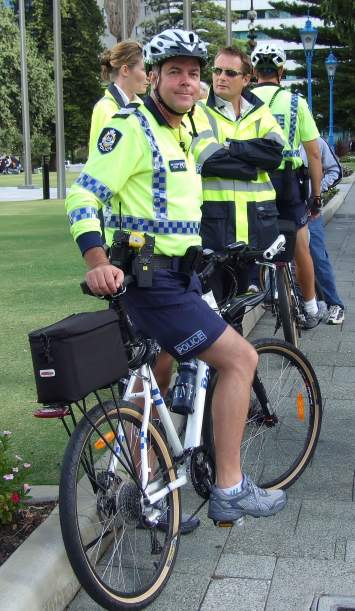
Cycling advocates always try to play up the positive aspects of cycling. Bikes reduce congestion and lessen pollution. Bikes provide health benefits as well as providing a mode of transportation for people who either cannot afford or choose not to own a motor vehicle. In short, bikes are a good thing.
When we think of cycling, we conjure up images of bicycle racing, rugged bike commuters, groups of bike club members cycling along suburban roads, and families enjoying a bicycle outing on bike paths or sidewalks.
Our image of cycling revolves around ideas about recreation, sport, and transportation. Bicycles are also seen as a childhood rite of passage. Most children start out riding wheeled toys after which they graduate to tricycles. Once they’re big enough, they move up to a two wheel bicycle. Initially, they use training wheels to steady the bike until they can balance and pedal without assistance. This ability to ride a two wheel bike is a major milestone for kids and a positive event in their lives.
So, all in all, cycling has many positive benefits. However, as with most things in life, there are always those few individuals who will take something positive and turn it into something negative. Typically, this is done for personal gain. And such has been the case with cycling.
Not long ago, I became aware of a new trend in bicycle use. This use of bicycles allows a rider to cause harm with a bike instead of the usual good bicycles are known for. I am talking about criminals using bikes in the commission of crimes.
Once in a while the media reports on a case where a criminal used a bike to either travel to or away from the scene of a crime. Such reporting has been intermittent, making the activity seem rare. However, one particular report in the Washington Post, which didn’t garner much attention at the time of publication, compiled a list of crimes committed in the Washington area.
They reported the following:
“In recent weeks, a number of robberies on city streets have been reported in which thieves approach and flee on two wheels. A robbery reported Sunday was only the latest. The incident, which police described as a robbery by force and violence, occurred about 4 a.m. in the unit block of New York Avenue NE. At least one robber in a group of four or five was said to have headed away on a bike.
Earlier this year, bikes were used in two notable incidents. In one, a man on a bicycle committed a sexual assault in the Dupont Circle area. In the other, a man on a city Bikeshare bike struck a pedestrian in the face and pedaled off with her iPhone.
Other incidents in which bikes were used in crimes attracted less attention, but they seem to occur with some regularity.”
At the beginning of the article, the author mentioned that the value of bicycles in commuting and running errands had been drawing increasing attention in Washington. No doubt, the successful Capital Bikeshare program has encouraged more people to use bikes as a mode of transportation. The increasing visibility of bicycles in this context has given rise to new ideas about how bikes can be used.
To play devil’s advocate, when traveling to the scene of a crime, bikes are easier to park. They are more maneuverable than cars and they can be ridden into areas where cars can’t fit and aren’t allowed to drive. Bikes draw less attention from passers-by. And they are virtually silent. These characteristics provide more options for escape and make it easier to go undetected in a crowd.
Criminals are limited in the direction they can drive when using a getaway car to escape the scene of a crime. Planning a motor vehicle getaway route can be difficult. Traffic patterns can’t be predicted. Patrolling police car positions can’t be anticipated. And, after committing to a particular route, alternative routes are few and far between.
Clearly, bikes offer criminals many advantages over cars. In addition to the advantages mentioned above, bikes are especially useful in crimes today because of the novelty involved in using them this way. Witnesses don’t normally associate bikes with crimes. Part of the reason is that non-cyclists are often unaware of how fast bikes can go.
To estimate speeds, cycling is often compared to driving and is relatively slow in comparison. Yet a fit criminal can easily attain speeds of 25 to 30 mph, which is fast enough to sprint out of sight and dart around a corner before bystanders can react.
On the bright side, a bicycle affords the criminal less protection. A good Samaritan could grab the biking criminal and pull him off of the bike. Knocking him to the ground might also cause him to drop whatever loot he had on him at the time. Unless the criminal was armed, it would be much easier to slow him down or apprehend him in cases where he was unable to quickly slither into some narrow alley and get away.
What does this negative bicycle use and negative publicity mean for cycling?
For those who hate cyclists, it will serve as more evidence that cyclists are scofflaws. Cyclist-haters will equate the criminal element with cycling. It will give them one more reason to be aggressive towards cyclists when interacting with them on the roads. For cyclists and more open-minded drivers, it will draw awareness to a bicycle’s many uses and serve as a reminder to watch carefully for bikes at all times.
At a time when bicycles are just beginning to come into their own, it is disheartening to see people misusing them for personal gain. Still, for the optimists among us it is also a sign that bicycles are becoming more integrated into society. They are slowly replacing cars, for good or for evil, but replacing cars nonetheless.



